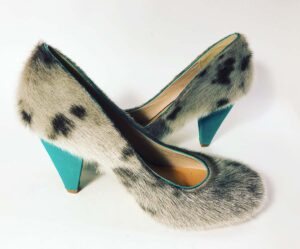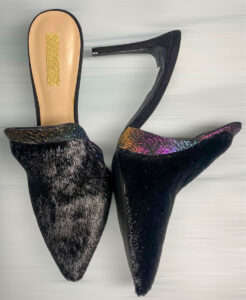ENB Artisan: The eco-friendly boutique merging natural materials with contemporary design
By Lubna bin Zayyad

Nicole Camphaug is an Iqaluit-based self-taught artist and owner of the eco-friendly online boutique ENB Artisan. Named after her husband Edgardo, herself and her daughter Barree (ENB), the business is a husband and wife initiative that focuses on merging natural materials with everyday items like furniture, pens and most famously, seal fur, seal leather and fish skin leather footwear.
She was inspired to handcraft jewellery using local materials after visiting a small community in Nunavut. She saw an artist craft a beautiful bracelet out of caribou antler that featured seven little inuksuit.
“When I got back {home}, I decided I’m going to get some caribou antler and then [it] just kind of went from there.”
ENB Artisan was born out of Nicole and Edgardo’s love for creativity and design. The business very much focuses on and showcases Nicole’s Inuk heritage. The couple sells gorgeous, hand-carved caribou antler pens, delicate bone and carved earrings. The most popular product is a collection of bespoke handmade seal fur covered loafers, boots and high heels. A high-end addition is a pair of dyed black harp seal fur-wrapped boots with raw diamond chip accents.
For Nicole, it was essential to incorporate materials that are part of her community’s heritage and history.
“Using seal fur, of course, is so important to Inuit because it has kept us warm, and the seal meat has kept us nourished, and it’s just such a big part of our culture.”

She explains that various seal fur grades depend on the intended use. For most footwear and even items like mittens or Annuraaq, it is important to source fur in its most natural (unprocessed) form to retain its natural waterproof properties. However, Nicole prefers to use commercially processed and tanned pelts because they are softer to work with, and it is easier to move and place the material around the footwear.
There are different ways to acquire seal fur in Nunavut, including going to local trappers and hunters. For the most part, Nicole, like others, goes to the Department of Environment to make purchases. The territory’s Seal and Fur Programs Policy offers fair compensation to harvesters for furs and seal pelts and helps them to access different markets for sales.
“I had these low-grade quality furs [and] I was trying to figure out something to do with them, and I had a pair of brand new boots, and I thought, ‘I’m going to try and add some little accents’, and they turned out pretty good,” she says.

With the first pair of boots turning out well, Nicole decided to try applying the same technique to a pair of stilettos. “My husband and I, we’re such a team in our art that we sat there back and forth trying to figure out how to get this [fur] on patent leather stilettos.”
You can’t just take a single pattern and apply it to different pairs of shoes. Nicole explains that each pair of shoes are unique because the pattern is hand cut to match the style of the shoe. At first, Nicole wasn’t sure how people would react to fur-lined stilettos, but once she revealed them to her friends, they were “over the moon because [it was] such a nice way to celebrate the seal, [and] not just in the wintertime.” The concept is popular, and many Iqalungmiut come to Nicole with their favourite pair of shoes that they want customized with seal fur, fish skin leather or seal leather.
However, with the pandemic impacting hundreds of businesses across the North, Nicole has seen a decline in sales. For the last two years, she has been unable to attend the big Christmas craft fair, and these days with nowhere to go, no big gatherings and local stay-at-home orders, there aren’t many occasions for people to wear a pair of showstopper shoes, let alone buy them.
“I think people aren’t going to these [events] and [so] they’re like, you know what, maybe I don’t need [the shoes] right now,” she says, “I mean, it’s really difficult to solely just be an artist in Nunavut.”
Both Nicole and her husband have day jobs, allowing them to work on the business from a place of creativity and love, rather than necessity.
“I feel lucky that I’ve got a day job that allows me to purchase larger amounts of seal fur, whereas if I was solely an artist, like so many, you might not be able to sell something before you can acquire more stock of something else that you need.”
Despite the challenges, Nicole wouldn’t change a thing, and she encourages others to do the same. “Just try. If I truly believe in it, I’ll continue trying until it is what I envision it to be, but if I don’t try, how will I ever know?”



